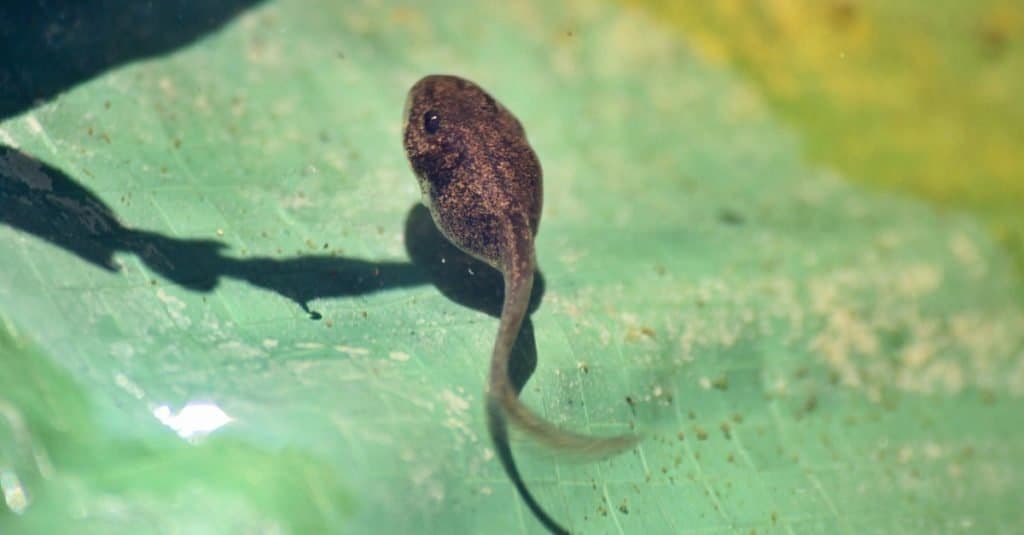
If you are a gardener, you may be happy when a toad makes its way over. The toad is useful in the garden since it naturally hunts insects, slugs, and snails. The presence of a resident toad minimizes the pest population and eliminates the need for harsh pesticides. Do you want to learn more about this bumpy amphibian? We’ve got the scoop on the average toad lifespan and other interesting facts about them!
The Rundown On Toads

Toads must blink to swallow because this forces their eyeballs against their mouths, forcing food down their throats.
©Bernie, CC BY-SA 3.0, via Wikimedia Commons – License
Toad is a popular term for some frogs, particularly those of the Bufonidae family. They have dry, leathery skin, short legs, and huge lumps covering their parotoid glands. The lumps are usually referred to as warts; however, they are not infectious. That is, you cannot develop warts from handling a toad.
There are around 350 species of toads. They also come in a variety of sizes. Oak toads are the smallest North American toads, measuring about 1.3 inches in length. Cane toads are the biggest toads, reaching lengths of up to 9 inches.
Toads have several defenses against predators, including the production of poison in the parotid glands behind the eyes. It is only dangerous if consumed or rubbed into the eyes. So you don’t necessarily want to go messing around with toads!
Now that we know more about toads, let’s explore the toad lifespan!
How Long Do Toads Live?
The average toad lifespan is 10-15 years in the wild, depending on the species. However, toads have been known to live up to 50 years in captivity.
Do you want to know how various long species of toads live? Let’s take a look at the lifespan of a few memorable toad species:
- American Toad: The average lifespan of the American toad is 2-10 years in the wild. However, it can live up to 30 years in captivity.
- Common Toad: The common toad has been observed to live between 10-12 years in the wild and up to 40 years in captivity.
- Cane Toad: The cane toad can live anywhere between 10-15 years in the wild. In captivity, it can live up to 20 years.
As anticipated, toads living in the wild have a much shorter lifespan. As they deal with many external factors outside their control, they are more susceptible to having their lives shortened.
The Average Toad Life Cycle
With a wealth of information on the toad lifespan, let’s look at how these amphibians develop from egg to full-grown toad! A toad’s life cycle is divided into three stages: egg, tadpole, and adult.
Egg
The egg stage is the initial stage of the toad life cycle. Adult females lay eggs in the water throughout the spring months. Eggs are released in a chain, in contrast to frogs, which deposit eggs in clusters. The bunches of eggs are referred to as spawn. Frogs lay their eggs in shallow water. This differs from toad eggs found in deep water, and their spawn wraps around many of the water’s plants.
Tadpole

Tadpoles live in water, where their gills enable them to breathe, while their tails and lateral lines help them survive.
©greggnormal/Shutterstock.com
Tadpoles hatch in one to three weeks. The color of the tadpoles is black. They have evolved enough to survive in water at this point, with gills and a mouth to breathe and feed. As tadpoles, they are restricted to the water. Tadpoles may feed on the leftover egg yolk at first, but they eat on plants in shallow water once this is gone.
Because the female produces hundreds of eggs, there are usually a lot of tadpoles in the water. Tadpoles are extremely vulnerable to predators such as newts, dragonflies, and fish, which is why the females will lay so many eggs to ensure a large amount of them can survive.
Adult Toad
As toads get older, they evolve legs to travel on land with lungs to breathe air. Their tail eventually begins to disappear. When the toad’s tail is absorbed, it enters maturity, the final stage of the toad’s life cycle. Adult toads are more likely to leave the water and spend most of their time on land.
What Factors Shorten A Toad’s Lifespan?

Toads have essential ecosystem benefits because they are vital in food chains.
©iStock.com/ttbphoto
The lifespan of toads is affected by food and predators and their size, gender, and habitat. Scientists have been increasingly aware of a worldwide reduction in the number of toads and frogs in recent years.
Some of the factors, in detail, include:
- Loss of habitat: The environment in which a toad eats, shelters, and breeds is referred to as its habitat. It will perish if it cannot locate appropriate conditions. As a result, it’s not unexpected that habitat loss is the most serious danger to toads. Humans destroy significant amounts of natural vegetation for homes and farmland, and wetlands are drained or let cattle graze on them.
- Pollution: Toads spend a large portion of their lives in water, and their wet skin is highly vulnerable to pollutants in the water. Chemicals in water, such as petrol, insecticides, detergents, and fertilizers all impact the water that toads live in.
- Invasive species: Invasive species pose a threat to toad populations all around the world. These species can compete for resources with native toads and transmit new illnesses.
- Predators: Despite having defense mechanisms, such as the release of poison, toads still have to watch out for predators. The most common predators of toads include snakes, raccoons, and birds of prey.
The photo featured at the top of this post is © Tom Reichner/Shutterstock.com
Thank you for reading! Have some feedback for us? Contact the AZ Animals editorial team.






